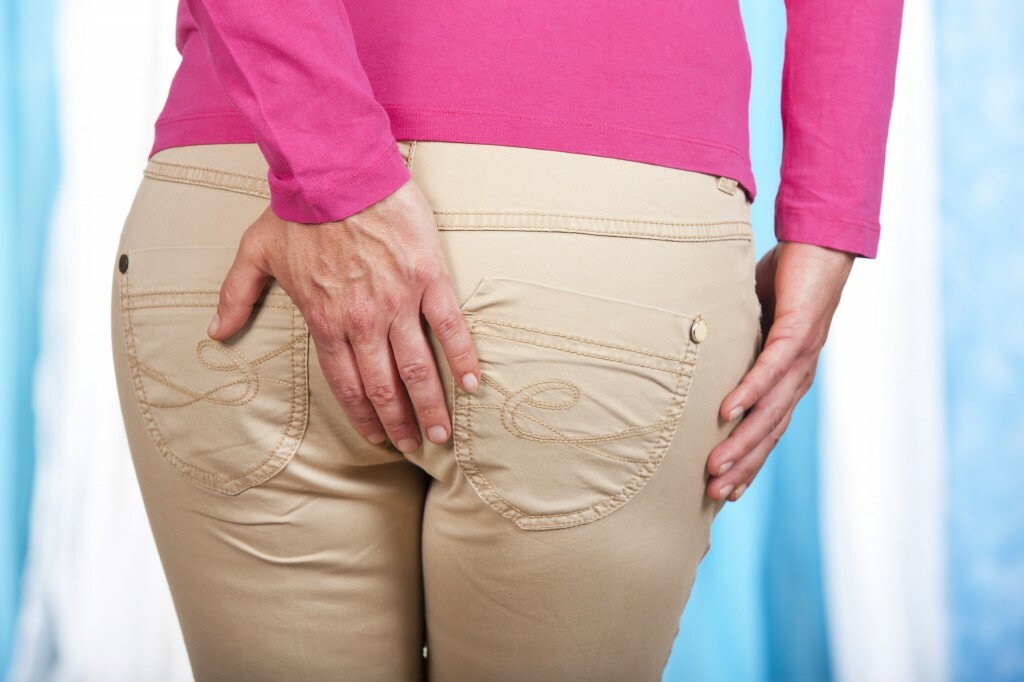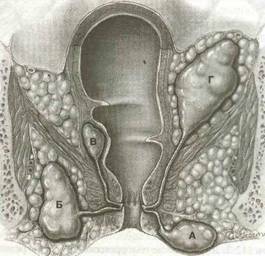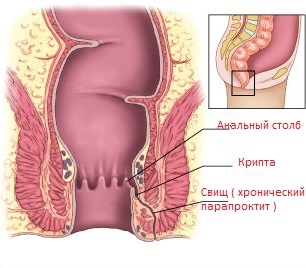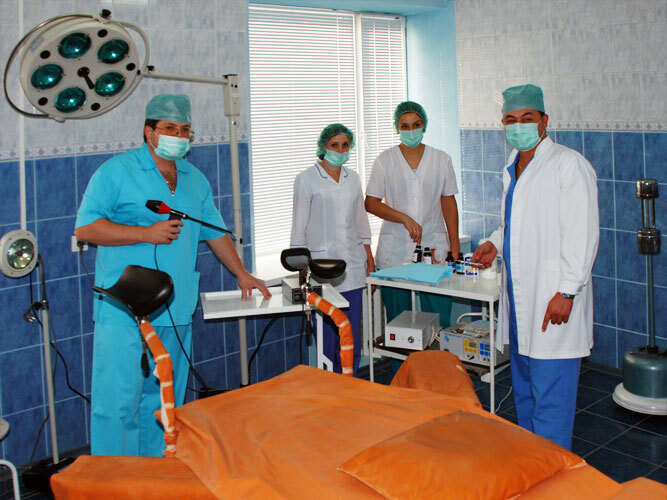Paraproctitis - symptoms, forms and methods of treatment
 Paraproctitis is an inflammatory process that develops in tissues surrounding the rectum.The onset of the first symptoms of this pathological process is always associated with the penetration of infection through the anal glands from the lumen of the rectum into the deep layers of the pararectal area.
Paraproctitis is an inflammatory process that develops in tissues surrounding the rectum.The onset of the first symptoms of this pathological process is always associated with the penetration of infection through the anal glands from the lumen of the rectum into the deep layers of the pararectal area.
The most common pathogens of infection, which in turn provoke the development of paraproctitis, are streptococci, Escherichia coli, Staphylococci.In very rare cases, doctors note that the development of this pathological process is associated with the growth of atypical pathogens - tuberculosis, clostridia or actinomycosis.
Contents Forms of paraproctitis Paraproctitis causes paraproctitis Symptoms How paraproctitis is diagnosedParaproctitis forms
Like every disease, the pathological process under consideration can proceed in two forms - acute and chronic.
The acute form of paraproctitis can occur in different types of :
- Subcutaneous paraproctitis.Some doctors refer to it as a pararectal abscess, this type of disease is characterized by purulent melting of subcutaneous tissue in the perianal region.Subcutaneous paraproctitis is a type of pathology under consideration that is most easily treatable and has exceptionally positive predictions provided timely medical care is received.
- Intrasfinctory( interspersed) paraproctitis.In this case, the inflammatory process affects the anal sphincter directly - its tissues are affected.
- Ishiorectal paraproctitis.With the development of this type of pathological process under consideration, it is a question of purulent inflammation with localization in the ileo-rectum fossa.
- Pelviorectal paraproctitis.The purulent process actively develops inside the small pelvis.
 The following types of paraproctitis are indicated in the figure:
The following types of paraproctitis are indicated in the figure:
- ( A) - subcutaneous paraproctitis;
- ( B) - ischiorectal paraproctitis;
- ( B) - inter-sphincter paraproctitis;
- ( D) is a pelvioreceptal paraproctitis.
Chronic paraproctitis is always a consequence of an incomplete acute form of paraproctitis.Often the transition of primary paraproctitis to chronic with frequent relapses is noted by physicians in patients who engaged in self-medication without using the methods of official medicine.In this case, there may be an opening of the abscess in the anal, which does not heal for a long time - in its place a fistula is formed.And such a "final" of self-treatment leads to the next stage of therapy, which does not always lead to complete success - the fistula periodically inflames and this can be facilitated by even a short-term constipation.
Causes of paraproctitis
The causes of the inflammation in the circulatory tissues can be :
- Hemorrhoids;
- cracks in the anus( anal fissures);
- inflammation of the anal glands.
In fact, paraproctitis is one of the complications of these diseases - it can only develop as a consequence of improperly performed / self-interrupted treatment.
Symptoms of paraproctitis
As paraproctitis is a purulent inflammatory process, it will be characterized by the classical symptoms of :
- increasing body temperature to critical levels;
- pain syndrome in the field of paraproctitis education - patients complain of the inability to sit and walk;
- the tissues around the anus are red-blue in color;
- the patient himself, when he feels the place of development of the inflammatory process, determines the puffiness of the tissues.
The acute form of paraproctitis is characterized by general signs of organism intoxication - nausea and dizziness, vomiting and slight tremor of the upper extremities, strong weakness.There is necessarily a suppuration.
Chronic paraproctitis has all the symptoms inherent in the acute form of the disease, but in a less pronounced form.The considered inflammatory process of a chronic nature has one peculiarity - it always leads to the formation of a fistula.Through the hole of the fistula, the purulent-soured liquid flows regularly-constant irritation of the perineum leads to the appearance of severe itching.
 If the fistula in chronic paraproctitis has excellent drainage( there is absolutely free exit for purulent contents), then this manifestation of the disease does not practically disturb the patient.There is pain syndrome only with an incomplete internal fistula, and the pain becomes more intense during the act of defecation, and immediately after bowel movement the patient's condition returns to normal.
If the fistula in chronic paraproctitis has excellent drainage( there is absolutely free exit for purulent contents), then this manifestation of the disease does not practically disturb the patient.There is pain syndrome only with an incomplete internal fistula, and the pain becomes more intense during the act of defecation, and immediately after bowel movement the patient's condition returns to normal.
In general, the symptoms of the fistula in chronic paraproctitis are manifested wavyly - this is due to the periodic filling of the fistula with purulent contents, then its occlusion and breakthrough.
Important: if blood deposits are found in the purulent contents of the fistula, then this is an immediate reason to consult a doctor.This sign may indicate the development of malignant / cancer cells.
How to diagnose paraproctitis
To make a preliminary diagnosis, it is enough for the proctologist to conduct a survey and examine the patient.To clarify the diagnosis of "paraproctitis" it is desirable to conduct a physical examination, palpation of the place of apparent localization of the inflammation focus.But very often the patient simply is not able to withstand such examinations - the inflammatory process under consideration is characterized by an intense pain syndrome, therefore, proctologists at paraproctitis never perform instrumental examinations at all.
As a mandatory examination for the diagnosis of using a laboratory blood test - in the material will be increased the number of leukocytes and increased the rate of erythrocyte sedimentation( ESR).
Diagnostics of chronic paraproctitis
 The doctor diagnoses the chronic form of the inflammatory process in progress :
The doctor diagnoses the chronic form of the inflammatory process in progress :
- examination of the perineum;
- examination of the anus;
- digital anal examination of the anal canal;
- fistula probing( if available) - this allows you to determine its course.
In the diagnosis of chronic paraproctitis, physicians actively use and instrumental examinations :
- sigmoidoscopy;
- fistulography;
- ultrasonography;
- anoscopy.
Principles of treatment of paraproctitis
Any form of the inflammatory process in question requires surgical intervention. In acute paraproctitis, the following activities of are performed:
- autopsy of a purulent focus;
- pumping out the contents;
- definition of the source of infection;
- excising / removing the source of infection along with purulent circulation.
Paraproctitis surgery is performed using epidural or sacral anesthesia.In case of lesions of the abdominal cavity, the patient receives general anesthesia during surgical treatment.
Note: only after the opening of the purulent focus and its complete purification from the contents, after excision of the foci of infection and a purulent course, one can hope for a full recovery.If the patient asked the doctors for help in a timely manner and the paraproctitis operation was performed without any complications, the recurrences of paraproctitis are extremely rare.
 If the patient is diagnosed with chronic paraproctitis, then it will be necessary to excise the formed fistula.But during an active purulent inflammation of the paraproctic fistula, surgery is contraindicated, so doctors first open the abscesses, purify them of the contents and drain them - then you can start the operation.
If the patient is diagnosed with chronic paraproctitis, then it will be necessary to excise the formed fistula.But during an active purulent inflammation of the paraproctic fistula, surgery is contraindicated, so doctors first open the abscesses, purify them of the contents and drain them - then you can start the operation.
If there are infiltrated areas in the fistula, physicians first conduct antibiotic therapy using physiotherapy methods.But the operation to remove the fistula should be done as quickly as possible after the preliminary treatment - a relapse with a purulent inflammation is inevitable.
Important: old age, severe physical illnesses and the closure of fistulous strokes are contraindications to the surgical treatment of chronic paraproctitis.Doctors should first stabilize the patient's condition and only then send him to surgical treatment.
Traditional medicine
Paraproctitis can not be cured with the help of traditional medicine recipes.To be more precise, it is possible to significantly alleviate the patient's condition, relieve him of unpleasant symptoms, but relapses and complications in the treatment of paraproctitis by folk remedies are inevitable.Therefore, visiting a doctor, clarifying the diagnosis and getting a referral for surgical treatment is mandatory.
What will ease the condition of the patient with paraproctitis :
-
 Solution / decoction of wood ash.It is necessary to take about 70 g of wood ash( this is about two handfuls of female hands), pour 7 liters of water and put on the fire - the cooking time from the boiling point should not exceed 30 minutes.Then the resulting product is filtered and cooled to a temperature that the skin would withstand.With the help of a decoction of ash, sit the baths - poured into the dishes( bath / basin / trough) cooked and lowered sore spot.Time of procedure - 25 minutes.The duration of the course of such treatment is 3-5 days.Some argue that after 3 days of the daily procedure with the decoction of the wood ash, the paraproctitis completely disappears - official medicine does not give such a conclusion.
Solution / decoction of wood ash.It is necessary to take about 70 g of wood ash( this is about two handfuls of female hands), pour 7 liters of water and put on the fire - the cooking time from the boiling point should not exceed 30 minutes.Then the resulting product is filtered and cooled to a temperature that the skin would withstand.With the help of a decoction of ash, sit the baths - poured into the dishes( bath / basin / trough) cooked and lowered sore spot.Time of procedure - 25 minutes.The duration of the course of such treatment is 3-5 days.Some argue that after 3 days of the daily procedure with the decoction of the wood ash, the paraproctitis completely disappears - official medicine does not give such a conclusion. - Calendula.It is necessary to take a tablespoon of calendula flowers and pour a glass of boiling water.Infuse the medicine for 2 hours, then strain and enter into the rectum in the form of microclysters.Naturally, before the procedure the intestine needs to be cleared.
- Herbal collection.It is necessary to take in equal proportions camomile, sage and yarrow, mix and pour into a glass of boiled water 2 tablespoons of the mixture.Infuse for 2 hours, then - drain and use for microblogging.
Possible complications of paraproctitis
Paraproctitis is a rather dangerous disease, as it proceeds with the obligatory formation of a purulent abscess. Doctors distinguish several possible complications of the considered disease :
- purulent fusion of intestinal wall layers;
- exit of stool to pararectal tissue;
- breakthrough pus in the retroperitoneal space;
- peritonitis.
Most often, these complications result in the development of sepsis - infection in the bloodstream, which is actually a fatal outcome for the patient.
And even if a purulent abscess has already been formed, but its breakthrough was realized in an independent mode, its contents fall on the crotch, anus.It seems to the patient that all the pus came out, especially as well as the state of health improves dramatically.And in fact, in the absence of competent cleaning of the abscess, the installation of drainage is likely to form a repeated purulent abscess or fistula.
The complications of chronic paraproctitis include :
- deformation of the anal canal area;
- rectal deformities;
- changes in scarring on tissues;
- incomplete closure of the anal passage;
- abnormal scarring of the walls of the anal passage;
- leakage of intestinal contents.
Important: if the fistula exists long enough, its tissue cells can degenerate into malignant cells.Doctors say that 5 years of regular recurrence and progression of the paraproctitis fistula is sufficient for the diagnosis of cancer.
Forecast of
If, in the acute course of the inflammatory process under consideration, a doctor's appointment was timely, we can safely expect a full recovery without possible relapses.
And even if the patient decided on surgical treatment already at the stage of the formed fistula in chronic paraproctitis, then excising and removing purulent moves also leads to a favorable prognosis.
It is impossible to give a favorable prognosis only when diagnosing chronic paraproctitis with fistula in patients who ignore the prescribed treatment.
Yana Tsygankova, medical reviewer, therapeutist of the highest qualification category.



